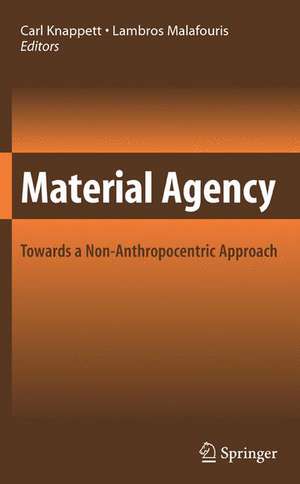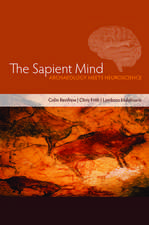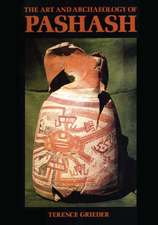Material Agency: Towards a Non-Anthropocentric Approach
Editat de Carl Knappett, Lambros Malafourisen Limba Engleză Hardback – 19 sep 2008
| Toate formatele și edițiile | Preț | Express |
|---|---|---|
| Paperback (1) | 992.81 lei 6-8 săpt. | |
| Springer Us – 5 noi 2010 | 992.81 lei 6-8 săpt. | |
| Hardback (1) | 997.23 lei 6-8 săpt. | |
| Springer Us – 19 sep 2008 | 997.23 lei 6-8 săpt. |
Preț: 997.23 lei
Preț vechi: 1216.13 lei
-18% Nou
Puncte Express: 1496
Preț estimativ în valută:
190.84€ • 207.23$ • 160.31£
190.84€ • 207.23$ • 160.31£
Carte tipărită la comandă
Livrare economică 22 aprilie-06 mai
Preluare comenzi: 021 569.72.76
Specificații
ISBN-13: 9780387747101
ISBN-10: 0387747109
Pagini: 256
Ilustrații: XX, 256 p. 49 illus.
Dimensiuni: 156 x 234 x 18 mm
Greutate: 0.52 kg
Ediția:2008
Editura: Springer Us
Colecția Springer
Locul publicării:New York, NY, United States
ISBN-10: 0387747109
Pagini: 256
Ilustrații: XX, 256 p. 49 illus.
Dimensiuni: 156 x 234 x 18 mm
Greutate: 0.52 kg
Ediția:2008
Editura: Springer Us
Colecția Springer
Locul publicării:New York, NY, United States
Public țintă
ResearchDescriere
Agency is a key theme that cross-cuts a wide raft of disciplines in the humanities, social sciences and beyond; yet it is invariably discussed separately behind closed disciplinary doors.
Within archaeology, agency has been characterized as a uniquely human attribute, and a means of incorporating individual intentionality into theoretical discourse. In other domains, however, notions of non-human and ‘material’ agency have been finding currency, and it is our aim to introduce some of these themes into archaeology and develop a non-anthropocentric approach to agency.
It is anticipated that such a perspective will not only help us achieve more convincing interpretations of the past, giving a more active role to material culture, but also throw new light on the changing role of artifacts in the present and the future.
This book is a groundbreaking attempt to address questions of non-human and material agency from a wide range of perspectives and disciplines: archaeology, anthropology, sociology, cognitive science, philosophy, and economics. The editors and authors demostrate that a distributed, relational approach to agency, incorporating both humans and artifacts, has important ramifications for how we understand material culture.
Within archaeology, agency has been characterized as a uniquely human attribute, and a means of incorporating individual intentionality into theoretical discourse. In other domains, however, notions of non-human and ‘material’ agency have been finding currency, and it is our aim to introduce some of these themes into archaeology and develop a non-anthropocentric approach to agency.
It is anticipated that such a perspective will not only help us achieve more convincing interpretations of the past, giving a more active role to material culture, but also throw new light on the changing role of artifacts in the present and the future.
This book is a groundbreaking attempt to address questions of non-human and material agency from a wide range of perspectives and disciplines: archaeology, anthropology, sociology, cognitive science, philosophy, and economics. The editors and authors demostrate that a distributed, relational approach to agency, incorporating both humans and artifacts, has important ramifications for how we understand material culture.
Cuprins
Where Brain, Body and World Collide.- At the Potter’s Wheel : An Argument for Material Agency.- Material Agency, Skills and History: Distributed Cognition and the Archaeology of Memory.- The Actor-Enacted: Cumbrian Sheep in 2001.- Non-Human Agencies: Trees in Place and Time.- Intelligent Artefacts at Home in the 21st Century.- In Context: Meaning, Materiality and Agency in the Process of Archaeological Recording.- The Neglected Networks of Material Agency: Artefacts, Pictures and Texts.- Some Stimulating Solutions.- On Mediation and Material Agency in the Peircean Semeiotic.- When ANT meets SPIDER: Social theory for arthropods.- Agency, Networks, Past and Future.
Textul de pe ultima copertă
Agency is a key theme that cross-cuts a wide raft of disciplines in the humanities, social sciences and beyond; yet it is invariably discussed separately behind closed disciplinary doors.
Within archaeology, agency has been characterized as a uniquely human attribute, and a means of incorporating individual intentionality into theoretical discourse. In other domains, however, notions of non-human and ‘material’ agency have been finding currency, and it is our aim to introduce some of these themes into archaeology and develop a non-anthropocentric approach to agency.
It is anticipated that such a perspective will not only help us achieve more convincing interpretations of the past, giving a more active role to material culture, but also throw new light on the changing role of artifacts in the present and the future.
This book is a groundbreaking attempt to address questions of non-human and material agency from a wide range of perspectives and disciplines: archaeology, anthropology, sociology, cognitive science, philosophy, and economics. The editors and authors demostrate that a distributed, relational approach to agency, incorporating both humans and artifacts, has important ramifications for how we understand material culture.
Within archaeology, agency has been characterized as a uniquely human attribute, and a means of incorporating individual intentionality into theoretical discourse. In other domains, however, notions of non-human and ‘material’ agency have been finding currency, and it is our aim to introduce some of these themes into archaeology and develop a non-anthropocentric approach to agency.
It is anticipated that such a perspective will not only help us achieve more convincing interpretations of the past, giving a more active role to material culture, but also throw new light on the changing role of artifacts in the present and the future.
This book is a groundbreaking attempt to address questions of non-human and material agency from a wide range of perspectives and disciplines: archaeology, anthropology, sociology, cognitive science, philosophy, and economics. The editors and authors demostrate that a distributed, relational approach to agency, incorporating both humans and artifacts, has important ramifications for how we understand material culture.
Caracteristici
The theory of agency is an important one in the social sciences and has always been assumed to be anthropocentric
This collection of archaeologists, anthropologists, sociologists and other social scientists use their understanding of agency to demonstrate that material culture or non-human entities also have agency
Includes supplementary material: sn.pub/extras
This collection of archaeologists, anthropologists, sociologists and other social scientists use their understanding of agency to demonstrate that material culture or non-human entities also have agency
Includes supplementary material: sn.pub/extras













